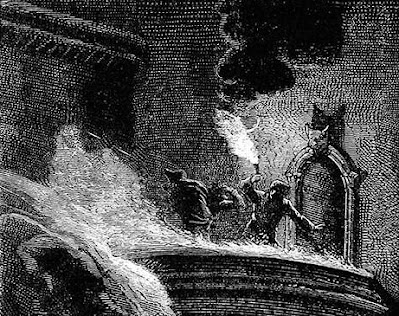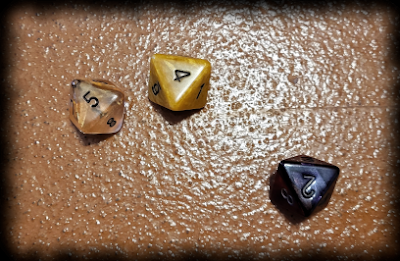
|
|
Scale: 10 ft. For a PDF version of this adventure, click HERE. |
Regarding doors:
Suitable for 2nd level characters.
1. Entry
A stairway terminates in an open space - the statue of a faceless man, arms crossed across his chest, stands in the center of the room. If the characters pass it by, a groaning can be heard - a mourning - almost as though the statue is lonely and enjoys their company. It is otherwise non-sentient.
2. Embalmer's Room
On the north wall are two wooden shelves sparsely populated by funerary tools - including picks for the removal of organs and preservative chemicals: bottled and caustic to smell. Some metal tools, rusted, lie on the floor.
3. Guardian Dead
Torn paper and cloth litter the floor. Seven Zombies (B44) stand aimlessly in the room. On the south wall, past the Zombies, a preserved corpse hangs chained to the wall, its feet off the ground, with a heavy chest affixed to it via the same chains. The chest has a padlock on it, but contains 1,000 silver pieces if opened.
4. Equality in the Grave
Two concrete slabs interrupt the stonework in the floor - parallel to one another, running north to south, like grave-covers. A torn purple banner hangs half-way on the north wall. The room is otherwise empty.
5. Four Pillars
Four columns - ionic in style - hold up the ceiling: equidistant from one another and from the outer walls of the room. Torch sconces - empty - are mounted to the east and west walls. The room is otherwise empty.
6. Tilting Coffin
The east and west walls of the space have a slow-rising ring about them: about one foot in depth, it starts at ground level at the door to the north and terminates at the secret door in the south, having reached the ceiling. Two braziers stand with ashes at this culmination.
In the center of the room is a metal coffin, upright and open - propped up by a stone pyramid, on a dark red-brown octagonal dais. If a character approaches, there is a chance the trap will trigger: the dais tilts aggressively backwards, prompting a Save vs Paralysis: on failure, the character falls into the coffin - which snaps shut and crushes the character for 2d8 damage.
If the character dies, the trap resets, spilling the pulp onto the floor. If the character survives, the trap does not reset, trapping the character inside until the others can find a way to retrieve their comrade.
7. Oratory
Stone benches - three to the west and three to the east, face northward towards a similar stone platform, 8 feet wide and elevated by 8 inches from the floor. A decorative chain rings the platform - valued at 90 gold pieces, if retrieved, but weighing 450 coin weight.
8. Robber's Corridor
Brass lamp stands line this hall - three each to the east and west - and aging evening blue valance slowly molders along the ceiling line. A Robber Fly (B41) is hidden among its drapings.
9. Lost Treasure
Two skeletons sprawl on the floor.
Against the south wall are several amphora - inside which can be found coins - 1,200 silver and 100 gold - in addition to some residues, implying liquids that once might have been valuable as well.
10. A Ladder Down
A dim blue light illuminates this room. In the center of the space, a circular platform slowly rotates - oddly, however, its foundations show no seam on the floor. Looking down into the platform, there are lines criss-crossing: the source of the illumination - and a ladder leading down. Room 16 is visible through the orifice - and that is where the ladder will lead if climbed.
The moaning of the statue in room 1 is still audible in this space.
11. Honorarium
Six plaster statues stand - supported at a slight angle by wooden sheets stuck into grooves in the floor - in formation, facing each other, east and west. On the south wall, an oval embossing decorates and frames a center image which has faded to time. The plaster figures appear unpainted - but if chipped away - actually house the bodies of forgotten, embalmed humanoids.
12. Junction
The moaning of the statue in room 1 is still audible in this space. Beyond it, however, it becomes too faint.
13. Snake & Saint
Two altars, north and south, funnel the eye to the far side of the room - where, in the west nook, a statue of a kneeling man rests. A Pit Viper (B42) is curled around the statue; at its feet and along the altars can be found 600 silver pieces, strewn about.
14. Zombie Pass-Way
A metal lattice runs across the ceiling - from which chains dangle, affixed beneath the lattice to allow movement, but not to exit the space. Eight Zombies (B44) are collared to the chains, having freedom of movement within room 14, but not outside of it. In the north-east and south-west corners of the room are stone constructs almost akin to hearths. In the north-east, ashes cover a box - in which 300 silver coins can be found; in the south-west, five gold-lined porcelain figurines: value 100 gold pieces each.
15. Tribute Room
The north and south walls house man-sized cubbies in which the skeletons of long dead and desiccated men at arms still stand. On the west wall is a mosaic depicting a kneeling figure in midnight blue armor; although the details and some of the color have worn off.
16. A Ladder Up
An oblong, hexagonal structure is divided asymmetrically in the center of the room - parts filled with water, parts dry. The water emits a thin blue light, illuminating the space.
A ladder extends - slowly rotating - upwards. If climbed, this ladder leads to room 10.
If placed in a jar, the water will continue to emit light for 2d4 turns before becoming mundane (albeit pure) water. Mundane water poured into the hexagonal retainer does not, itself, illuminate: instead visibly sinking to the bottom, where it forms a bubble - distinct in itself.
17. Beetle Sanctuary
A dead adventurer has been skeletonized by eight Oil Beetles (B31) who linger in the room. On the dead adventurer's person - among some largely useless mundane gear, can be found 200 silver pieces and a pearl worth 100 gold.
18. Undead Storage
Scraps of material - small and broken, largely unidentifiable - litter the floor. Eight Zombies (B44) occupy the room among the folderol.
19. A Gray Trick
A door in the south wall appears identical to other portcullis style doors in the complex - however hides a small sloped compartment behind it rather than a true room. Confined to the compartment is a Gray Ooze (B36), sliding out of the compartment as soon as the door is opened. The Gray Ooze will be entitled to a surprise round, if thus liberated.
Public domain or open license artwork retrieved from the
National Gallery of Art,
Pixabay, and
OldBookIllustrations.com. All artwork has been adapted for thematic use. Attributions in alt
text.




































